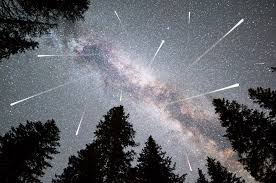
INDIANA — The Orionids, an annual meteor shower created by the debris of Halley’s Comet, has officially begun, offering skywatchers a chance to witness one of the most dazzling celestial events of the year. This year’s shower will be visible until late November, with optimal viewing conditions peaking from Sunday, October 20, through Monday, October 21.

During the peak night, observers can expect to see up to 20 meteors per hour, with some years seeing counts as high as 50 to 75. However, this year, a waning gibbous moon may interfere with visibility, casting a glow that could obscure the meteors. For the best chance to spot shooting stars, aim to watch just after dark before the moonlight intensifies.
What Causes the Orionids?
The Orionid meteor shower contains dust and debris from Comet Halley (1P/Halley). Although Halley last passed through the inner solar system in 1986 and won’t return until 2061, its remnants continue to cross Earth’s orbit each year, creating this stunning display. The meteors travel into Earth’s atmosphere at about 41 miles per second, resulting in the bright streaks of light that characterize the shower.
Halley’s Comet also gives rise to the Eta Aquarids meteor shower in May, marking its significance in multiple celestial events.
Where to Look
The meteor shower derives its name from the Orion constellation, which appears in the eastern sky around midnight. However, the meteors can be spotted anywhere in the sky, so viewers should keep their eyes wide open.
Viewing Tips
To enhance your meteor shower experience, NASA offers the following recommendations:
- Seek Dark Skies: Find a location far from urban light pollution for optimal viewing.
- Check the Weather: Clear skies are essential for seeing meteors.
- Dress Warmly: Nights can be chilly, so wear layers to stay comfortable.
- Allow Time: Spend at least 30 minutes outside to increase your chances of spotting meteors.
- Avoid Telescopes or Binoculars: These tools restrict your field of view and are not helpful for meteor showers.
- Use Red Light: If you need light, use red instead of white to preserve your night vision.
As the Orionids light up the night sky, don’t miss your chance to connect with this spectacular natural phenomenon. Grab a blanket, find a dark spot, and enjoy the show!



